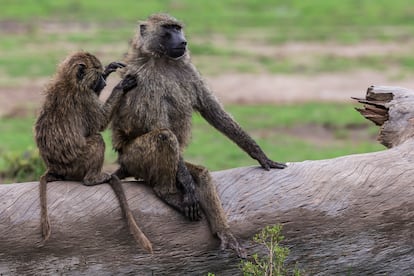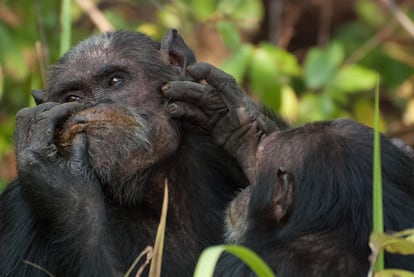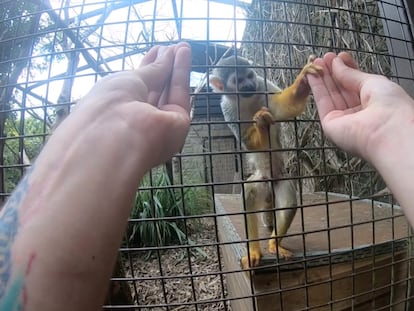Pacts among primates: How and why do they make them?
To improve their position in the hierarchy, many ape species have to form coalitions to seize power

In these times of political negotiations, it’s pertinent to point out that the motto of “unity is strength” isn’t only applicable to human beings. In nature, there’s a world that goes beyond pure competition. The first field research in primatology — conducted in the mid-20th century — quickly highlighted that monkeys formed coalitions. That is, that two or more individual monkeys joined forces against rivals of the same species.
A book on savanna baboons (Papio cynocephalus), published in 1965, reads: “It became clear that some of the adult males were constantly associating with each other and supporting each other in aggressive interactions with other males. Some of these males associated so closely that they almost never acted independently.”
The purpose of most primate coalitions is to bolster status in the hierarchy within the group. This allows certain primates to access resources, such as food and females. Frequently, two high-ranking individuals team up against a subordinate to reinforce their position. However, there are also cases of revolutionary coalitions, in which partners seek to overthrow a monkey of a higher rank.
The curious thing is that there are also quite a few species of primates who don’t create coalitions. For example, male chacma baboons (P. ursinus) — unlike other baboon species — only have antagonistic interactions with each other and rarely cooperate. What could be the reason for this? Well, some authors have pontificated that coalition-building is a complex behavior that requires advanced cognitive abilities. That is, only the most intelligent species are capable of establishing coalitions. However, an academic article published in 2014 refuted this hypothesis by analyzing 38 species of primates. The researchers concluded that what was most important were socioecological factors, such as group size.
Chacma baboons live in smaller groups than other baboons. Females tend to be in the majority. Therefore, males don’t form coalitions, for the simple fact that there are too few of them. This is reminiscent of the history of Spanish politics, where parties were forced to form more coalitions only after the two-party system weakened, and smaller parties began to pick up seats.
If there’s a clear difference between human coalitions and those made by monkeys, it’s perhaps in how they are forged. To reach agreements, politicians meet in their offices and express their interests. If the meeting has been fruitful, they shake hands and scribble on a piece of paper. But the rest of primates don’t have such sophisticated language: they require other systems to know who their allies are. The most widespread system is that of grooming — an activity that consists of removing lice from each other. When a monkey grooms another in an inaccessible area of the body, such as the back, it’s sending a message.
It was in the 1970s when the hypothesis was proposed that primates used grooming as a form of currency. That is, they groomed others so that they would return the favor in the future, whether via more grooming, or offering support in case of an attack. However, it wasn’t until 2006 that a meta-analysis corroborated the relationship between this generous grooming and coalition-building in primates. Of course, this isn’t necessarily the case in all species.
There are other less common methods to strengthen links. Guinea baboons (P. papio) frequently touch each other’s genitals. This makes sense: the genitals are a very important part of the body for any animal, as they’re essential for transmitting offspring. When a baboon lets another touch them, they’re engaging in an act of trust. On the island of Cabo Delgado, Puerto Rico, male macaques forge their alliances through homosexual sex. A recent study has shown that male monkeys who have sexual relations with each other are more likely to support each other in a conflict. This practice helps them rise in the social ranking and, therefore, reproduce more with females.

What other species of macaques do is use infants as a social tool to improve their relationships. This is usually practiced by low-ranking males when they want to approach another higher-ranking male, without being attacked by him. With a baby in their arms, they invite the other male to spend a peaceful moment together in close proximity, showing affection to the baby. Sometimes, this could be the starting point of a beautiful coalition.
So far, we’ve only talked about males, but what about females? Unlike male coalitions — which are often formed between unrelated individuals — female coalitions are usually between mothers and their daughters. For example, in savanna baboons, females stay in their natal group and inherit the rank of their mother, who will defend them against possible aggressors who try to usurp her position.
There is, however, a very striking exception: the bonobos (Pan paniscus). These are apes who, while physically similar to chimpanzees, have very different behavior. In chimpanzees, females are the dispersing sex (they go to another group to mate) and their social bonds are weak. Unlike males — whose coalitions are the day-to-day of their political strategies — they don’t usually make them and are frequently attacked by males who seek to coerce them. On the other hand, bonobos — although they’re also not related — form strong coalitions whose main function is to fight back against harassment by males. They are physically less strong, but, thanks to their union, they manage to be the dominant sex, escape aggression and gain earlier access to food.
In this matriarchy, aggression is much lower than in chimpanzees, since they release tension by having sex. Especially when they’re feeding and conflicts may arise, the females will stand in front of each other and rub their vaginas, becoming more tolerant of each other. This good environment is what allows them to form coalitions and confront the males who try to attack them.
Across the board, for all primates, the conclusion is the same: no coalition is forged out of nothing. Either the individuals are related, or they’ll have to work hard to create the necessary environment of tolerance and trust. Everyone chooses their method.
Sign up for our weekly newsletter to get more English-language news coverage from EL PAÍS USA Edition
Tu suscripción se está usando en otro dispositivo
¿Quieres añadir otro usuario a tu suscripción?
Si continúas leyendo en este dispositivo, no se podrá leer en el otro.
FlechaTu suscripción se está usando en otro dispositivo y solo puedes acceder a EL PAÍS desde un dispositivo a la vez.
Si quieres compartir tu cuenta, cambia tu suscripción a la modalidad Premium, así podrás añadir otro usuario. Cada uno accederá con su propia cuenta de email, lo que os permitirá personalizar vuestra experiencia en EL PAÍS.
¿Tienes una suscripción de empresa? Accede aquí para contratar más cuentas.
En el caso de no saber quién está usando tu cuenta, te recomendamos cambiar tu contraseña aquí.
Si decides continuar compartiendo tu cuenta, este mensaje se mostrará en tu dispositivo y en el de la otra persona que está usando tu cuenta de forma indefinida, afectando a tu experiencia de lectura. Puedes consultar aquí los términos y condiciones de la suscripción digital.
More information
Últimas noticias
NASA discovers Titan doesn’t have an ocean, but a ‘slushy ice layer’ that increases possibility of life
Innocence lost in the forest of the child soldiers: ‘Each leader of the armed group had his girls’
‘Fallout’ or how the world’s largest company turned an anti-capitalist apocalyptic Western into a phenomenon
From inflation to defending migrants: Eileen Higgins and Zohran Mamdani inaugurate the new Democratic resistance against Trump
Most viewed
- ‘El Limones’ and the growing union disguise of Mexican organized crime
- Christian Louboutin: ‘Young people don’t want to be like their parents. And if their parents wear sneakers, they’re going to look for something else’
- The low-cost creative revolution: How technology is making art accessible to everyone
- ‘We are dying’: Cuba sinks into a health crisis amid medicine shortages and misdiagnosis
- A mountaineer, accused of manslaughter for the death of his partner during a climb: He silenced his phone and refused a helicopter rescue











































